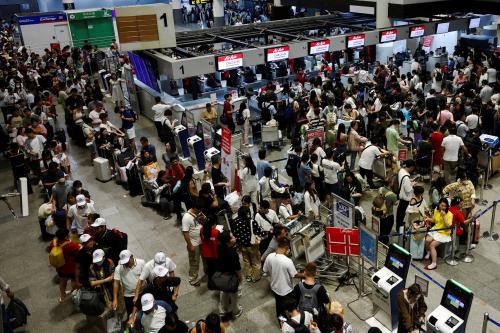This article is based on “The Fourth Industrial Revolution, Agricultural and Rural Innovation, and Implications for Public Policy and Investments: A Case of India” by Uma Lele and Sambuddha Goswami, forthcoming in Agricultural Economics, November 2017 Issue.
The extraordinary pace of technological change in the so-called “fourth industrial revolution”—well-articulated by Klaus Schwab, founder and executive chairman of the World Economic Forum—holds tremendous promise. Developing countries will have new opportunities to achieve inclusive agriculture and rural growth at an accelerated speed and transition toward high-productivity manufacturing and other economic sectors, but they also face new challenges.
Advances in computing power, connectivity, artificial intelligence, biotechnology, 3-D printing, geographic information system, and other technologies are enabling developing countries to leapfrog over many older technologies, in the same way that cellphones have made it unnecessary to install landlines. Such impactful change needs proactive public policymaking to build on the positive aspects of the new industrial revolution while preventing the further widening of the already large gap between the skilled and unskilled labor.
How will this play out in a developing country like India where even the first three industrial revolutions were incomplete? In 1843, the British colonizers sent an engineer to explore where to build railways for transporting cotton from the fields to their rapidly automated textile industry. It created the world’s largest railway network, but in the process killed India’s thriving domestic textile industry. In the 1920s, India’s first steel mill was established, the largest in the British Empire. It made inroads in the European market after liberalization of economic policies in 1991, only to suffer from subsidized Chinese steel production and exports. More recently, India became the largest exporter of software but now faces threat of decline with increased use of algorithms in back offices of importing countries, ranging from call centers to the banking sector, not to mention more restricted immigration policies in the U.S. Can India’s IT industry power be turned inwards to benefit millions of rural households?
India’s emerging public digital ecosystem
The government of India, through its Digital India Initiative has undertaken a wide variety of initiatives to take advantage of the fourth industrial revolution. The Ministry of Communication and Information Technology, with other ministries, is working to reform the state’s service delivery. India’s ambitious Goods and Services Tax system is establishing a uniform interface for taxpayers with a common information technology infrastructure, shared between the central government and the states. Common Services Centers, strategic cornerstones of Digital India, give access to various electronic services to villages and promote digital and financial inclusion, encourage rural entrepreneurship, and build rural capacities and livelihoods. These centers offer a bottom-up approach to social change, with a focus on rural citizens.
India’s triple innovation system (JAM)—Jan Dhan, the prime minister’s initiative to open universal bank accounts, depositing 1,000 rupees (approximately $15) per household; Aadhaar universal identification; and mobile phones—is the key vehicle for the delivery of safety nets.
Yet, the old-fashioned physical infrastructure is proving to be a constraint. Only 27 percent of villages have banks within 5 kilometers. The government is licensing payment banks, relying more on mobile phone payment technology, given over the 1,010 million mobile phones among India’s population of 1.3 billion. India has mandated support for at least one of 22 Indian languages, besides English and Hindi, in all mobile phones sold, beginning July 1, 2017 to make messaging accessible to the entire population.
The government has also focused on public distribution system (PDS) reforms. PDS, the world’s largest safety net of its kind for food grains and essential commodities, operates through a network of well over 521,000 Fair Price Shops (FPSs). Digitization of 230 million ration cards, with 56 percent seeded with a universal ID and Aadhaar, has reduced pilferage from the PDS over the past two years. Several states have now installed electronic point-of-sale devices at FPSs to track the sale of food grains on a real-time basis. The government is also shifting from distribution of food in kind to cash transfers, a highly debated policy shift.
The Mahatma Gandhi National Rural Employment Guarantee Scheme, again the largest in the world, guarantees up to 100 days of rural employment for those in need of employment at $1.5 a day. Using direct bank transfers to pay beneficiaries has reduced transfer costs, waste, and corruption. Previously, disbursements were based on forecasted expenditure, with funds transferred from the central government to the state, district, and panchayats, idling locally until expenditures were incurred (or misallocated and wasted), and never returned.
In April 2016, Prime Minister Modi launched an online platform for farmers, eNAM (National Agriculture Market), for integrating agricultural markets online, so that farmers and traders can access all Agriculture Produce Market Committee-related information and services, commodity arrivals and prices, and buy and sell trade offers. But market liberalization has been slow. India also launched a crop insurance scheme, the Pradhan Mantri Fasal Bima Yojana in 2016, covering 37 million farmers.
Digitized land registration, mobile phones, and “uberized” tractor service all contribute to improved farm management. Digital India Land Records Modernization Programme is updating millions land records, providing for title guarantees. Increased security of land tenure stimulates land rentals by non-viable small farmers and land consolidation.
Via Digital India, India has plans to connect 2.5 million Gram Panchayats (local governments) with high-speed internet by 2018, with hundreds of thousands already having access to the internet.
Despite these impressive changes, there is still a need for old-fashioned investment in transportation, power, and the internet to create more employment for women and youth in rural areas and human capital. Despite technology’s promise, around 25 percent of Indian adults cannot read or write. India needs to bridge the gender divide, particularly investing in rural women’s education and training. Innovative technologies can be a tremendous engine of growth, equity, and sustainability, but their geographical application is still limited in rural areas, and many farmers remain unaware of advancements. Insufficient connectivity in rural areas, lack of basic computer knowledge, and literacy hinders rapid development of e-agriculture. Substantial investment is needed in physical infrastructure, power, broadband, transportation, and education, particularly in poorer regions and in the poorest people.



Commentary
The fourth industrial revolution and rural transformation in India
September 28, 2017